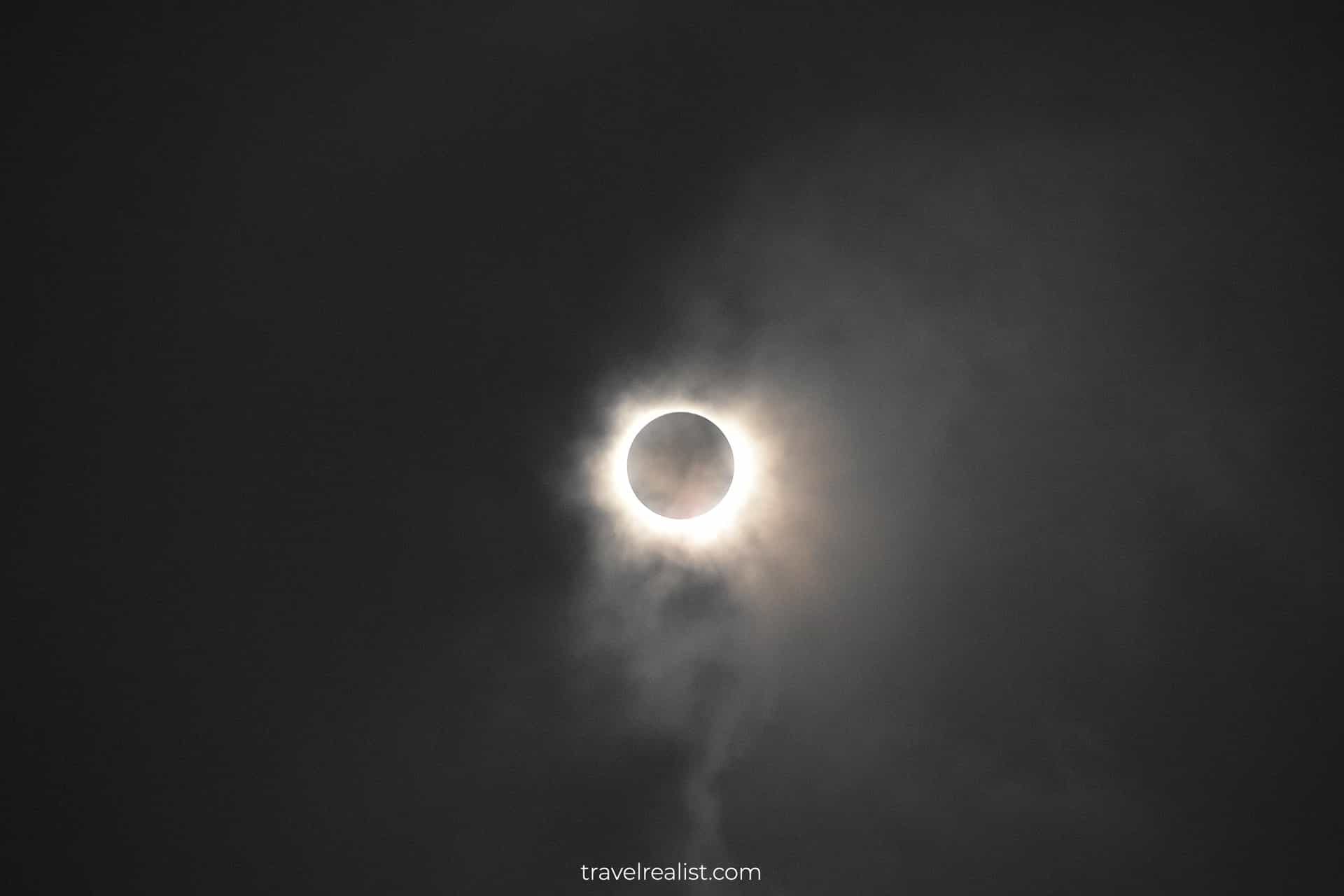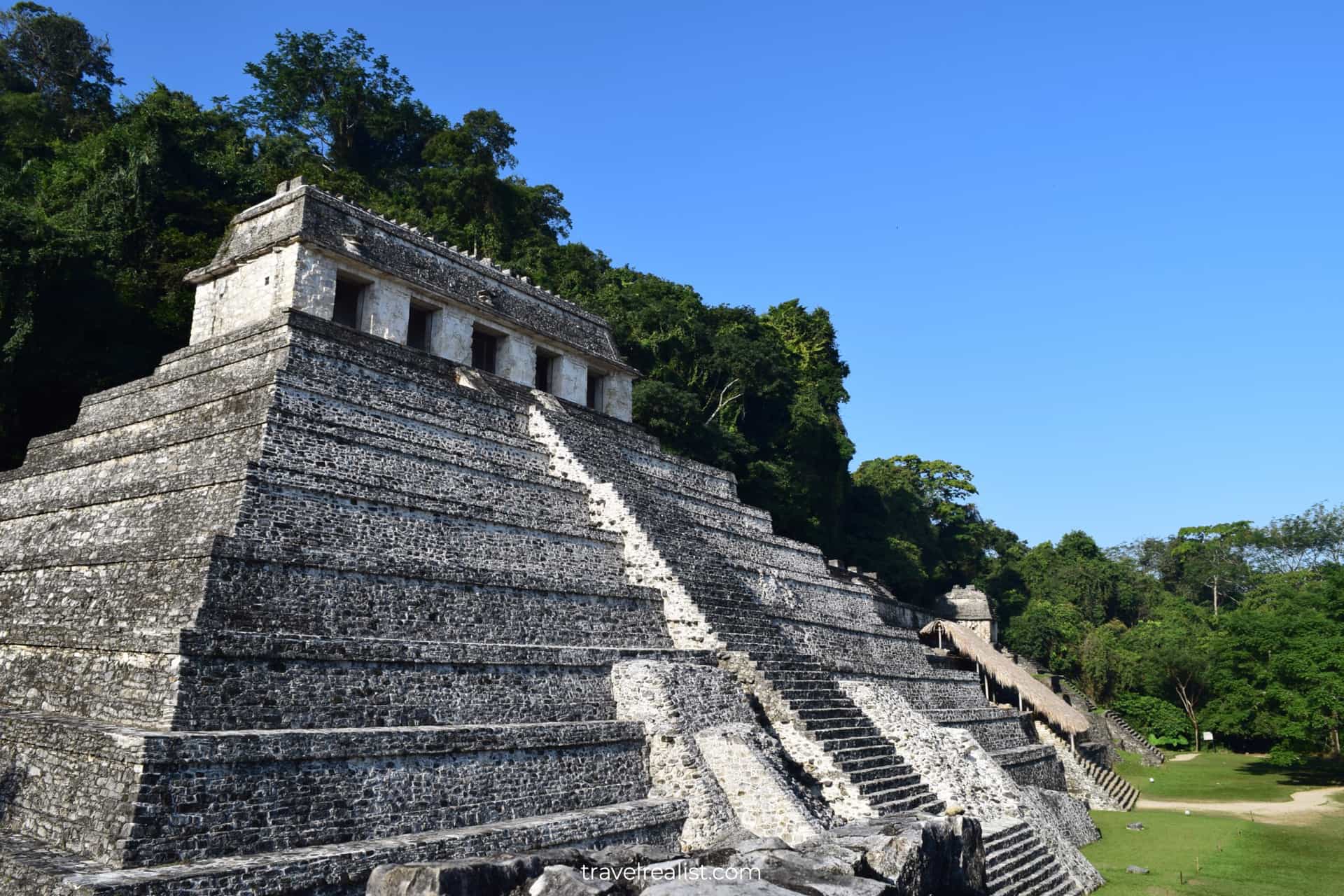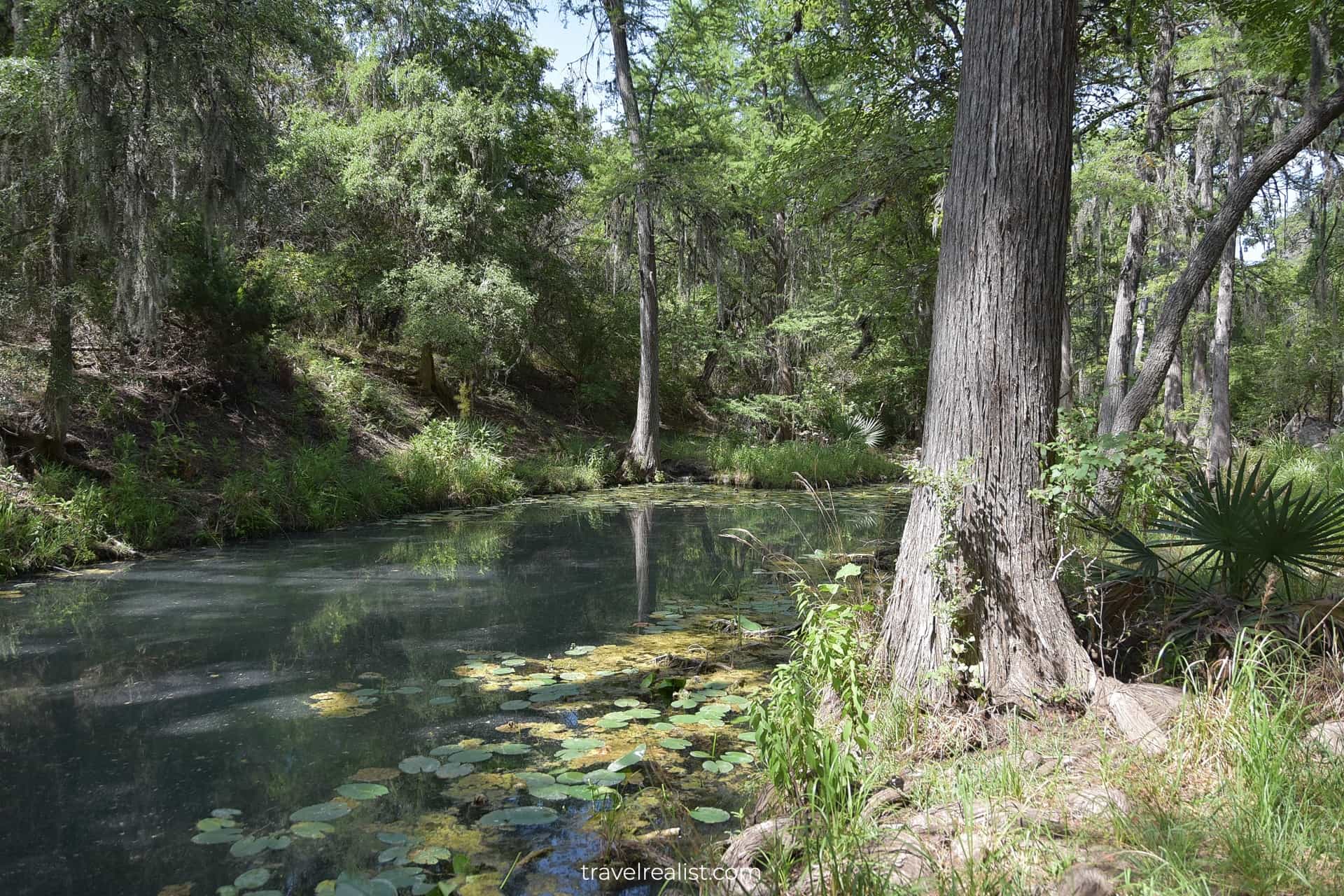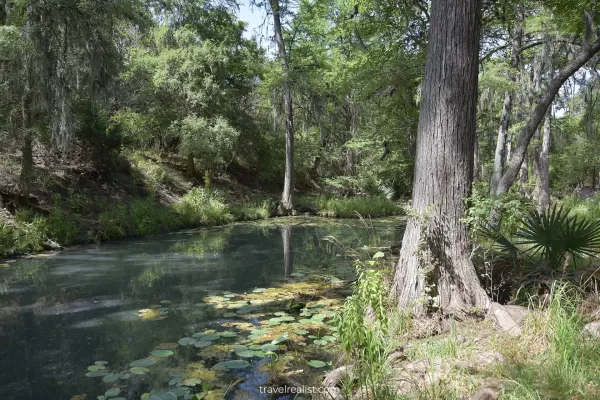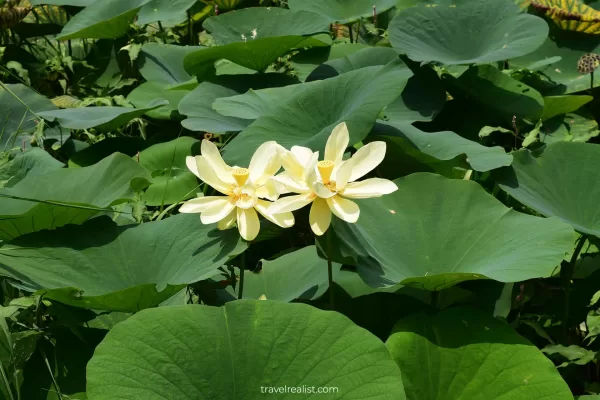San Francisco Maritime: Ships at Hyde Street Pier
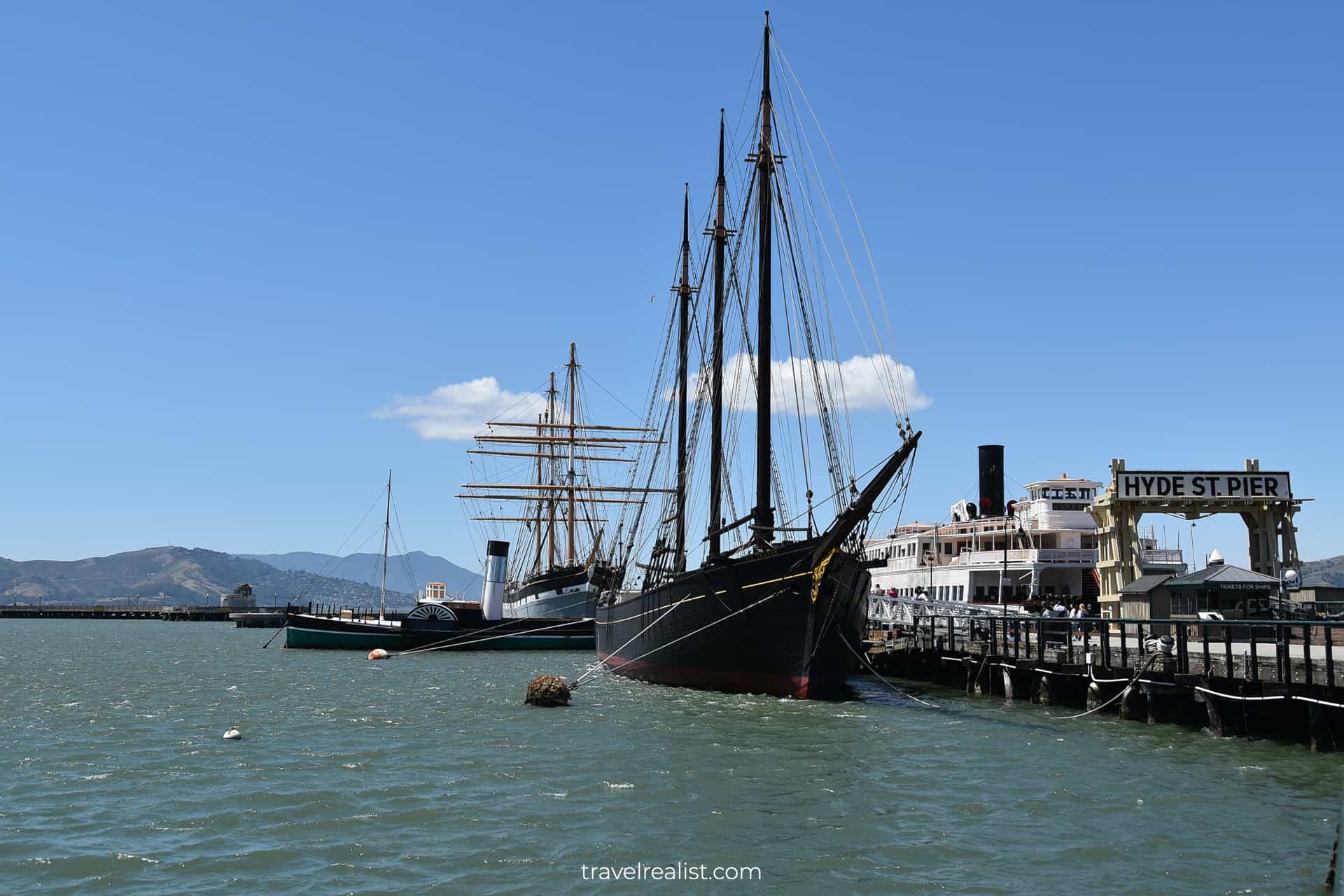
This realistic Guide to San Francisco Maritime Museum Ships helps you explore historic ships at Hyde Street Pier.
San Francisco Maritime is a National Historic Park. It protects a fleet of historic ships.
This post includes affiliate links that will earn us commission if you make a purchase via these links.
Sights & Places of Interest
There are six ships at the mooring at Hyde Street Pier. All of them date back to the late 19th and early 20th century. In a way, you can go back in time in this park.
Here is a look at all of the historic ships in the park.
- Lumber schooner C.A. Thayer is in the forefront.
- Paddlewheel tugboat Eppleton Hall is right behind it.
- Square-Rigger Balclutha, the oldest ship in the park, is next.
- Steam ferryboat Eureka is on the other side of the pier.
- Steam tug Hercules is hidden behind Eureka.
- Schooner Alma Scow is not in the picture. It is docked behind Hercules.
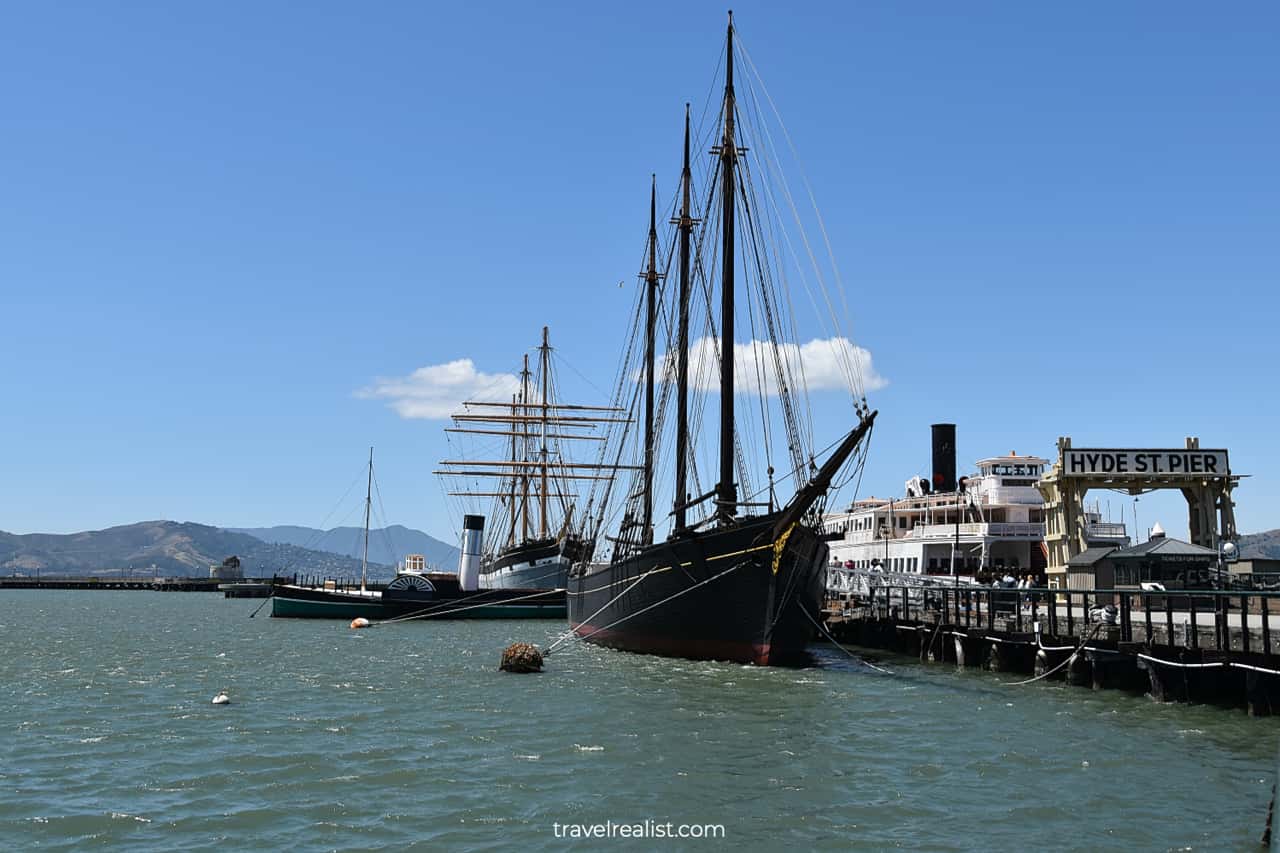
1. Lumber Schooner C.A. Thayer
C.A. Thayer will likely be the first ship you visit in San Francisco Maritime. This ship is the closest to the entrance to the pier.
C.A. Thayer was built in 1895 in California. The ship carried lumber until 1912. C.A. Thayer was a salmon and cod fishery between 1912 and 1950.
The ship has a distinct three mast design. This design was typical of lumber schooners of the late 19th century.
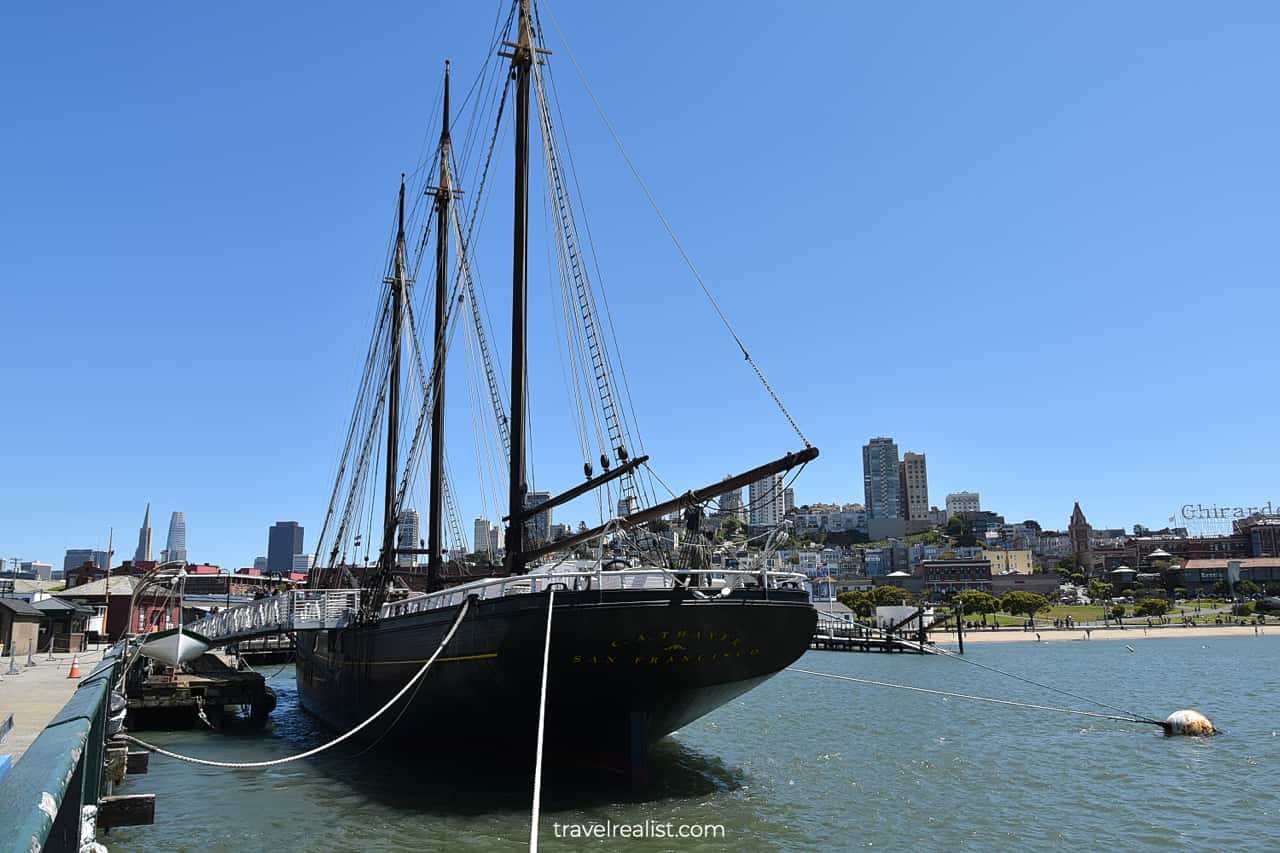
You can board C.A. Thayer. This is a great way to explore its deck and cabins. Yet, you could only get a sneak peak into the cargo hold.
You might run into volunteers on the ship on the summer weekends. These people are very knowledgable of the history of the ship. They could answer most questions about this and other ships.
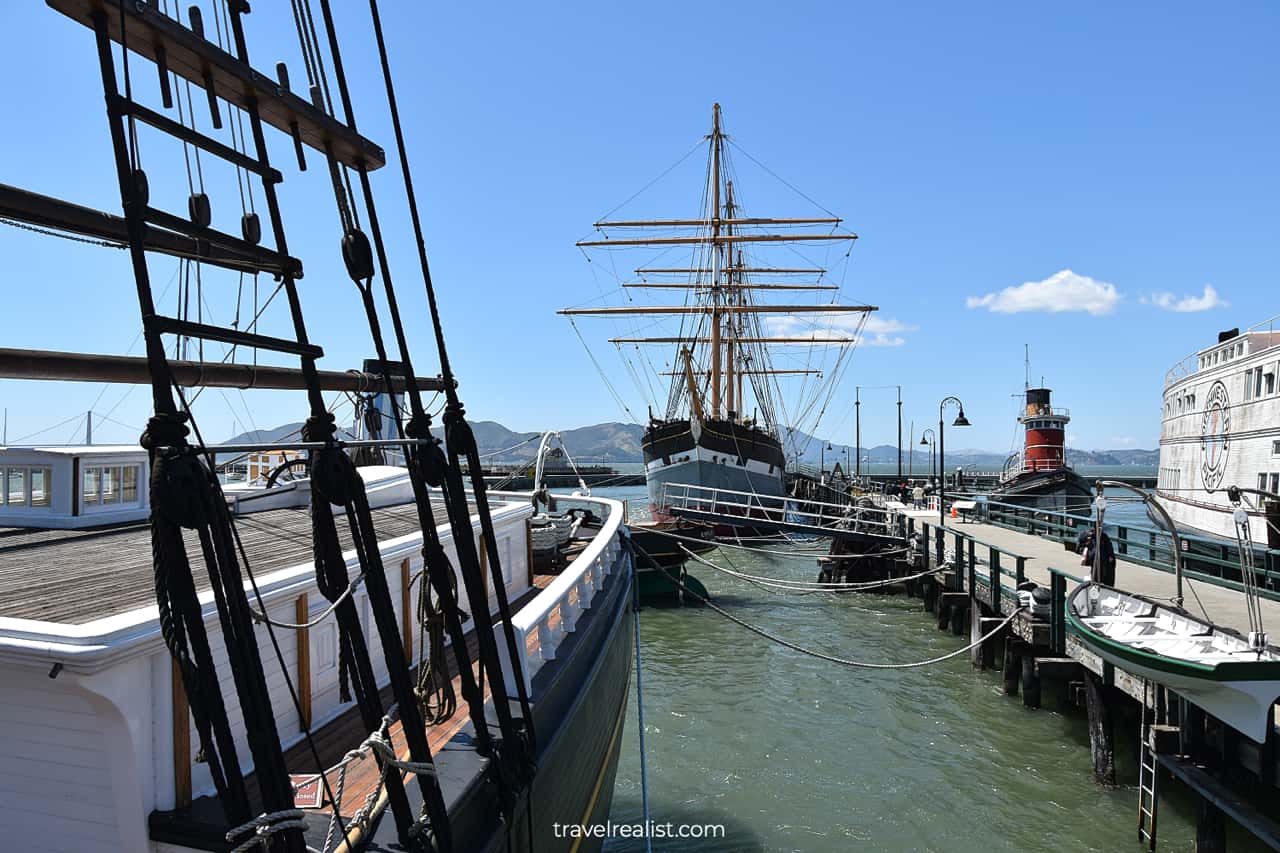
2. Paddlewheel Tugboat Eppleton Hall
You will see the next ship as soon as you get off C.A. Thayer. It is time to explore Eppleton Hall. This ship is a paddlewheel tugboat.
It is the youngest ship in the park. Yet, this ship is still over 100 years old. Eppleton Hall was built in England in 1914.
It is one of the few remaining English-built paddlewheel tugboats in the world. It was in service until 1964. National Park Service received it as a donation in 1979.
There is a gang plank that connects the ship with the pier. But Eppleton Hall is not open for public. You could only admire this somewhat strange looking ship from the pier.
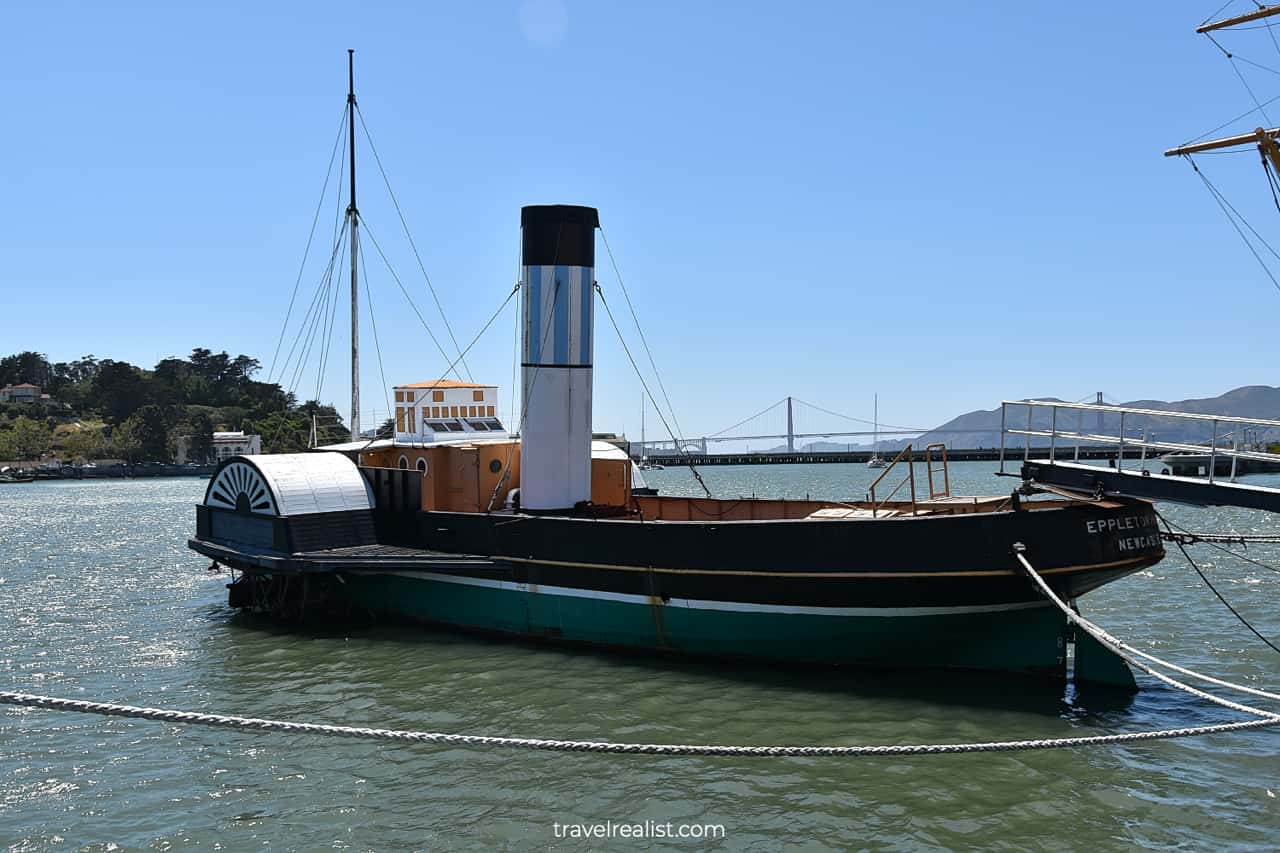
3. Square-Rigger Balclutha
You will approach Balclutha after a quick stop to admire Eppleton Hall. This steel-hulled square-rigger was built in Glasgow, Scotland in 1886. This makes it the oldest ship in San Francisco Maritime Museum.
The ship carried various types of cargo during its almost seven decades of active service. Its cargo ranged from lumber, coal, and oil to salmon, grain, and wine.
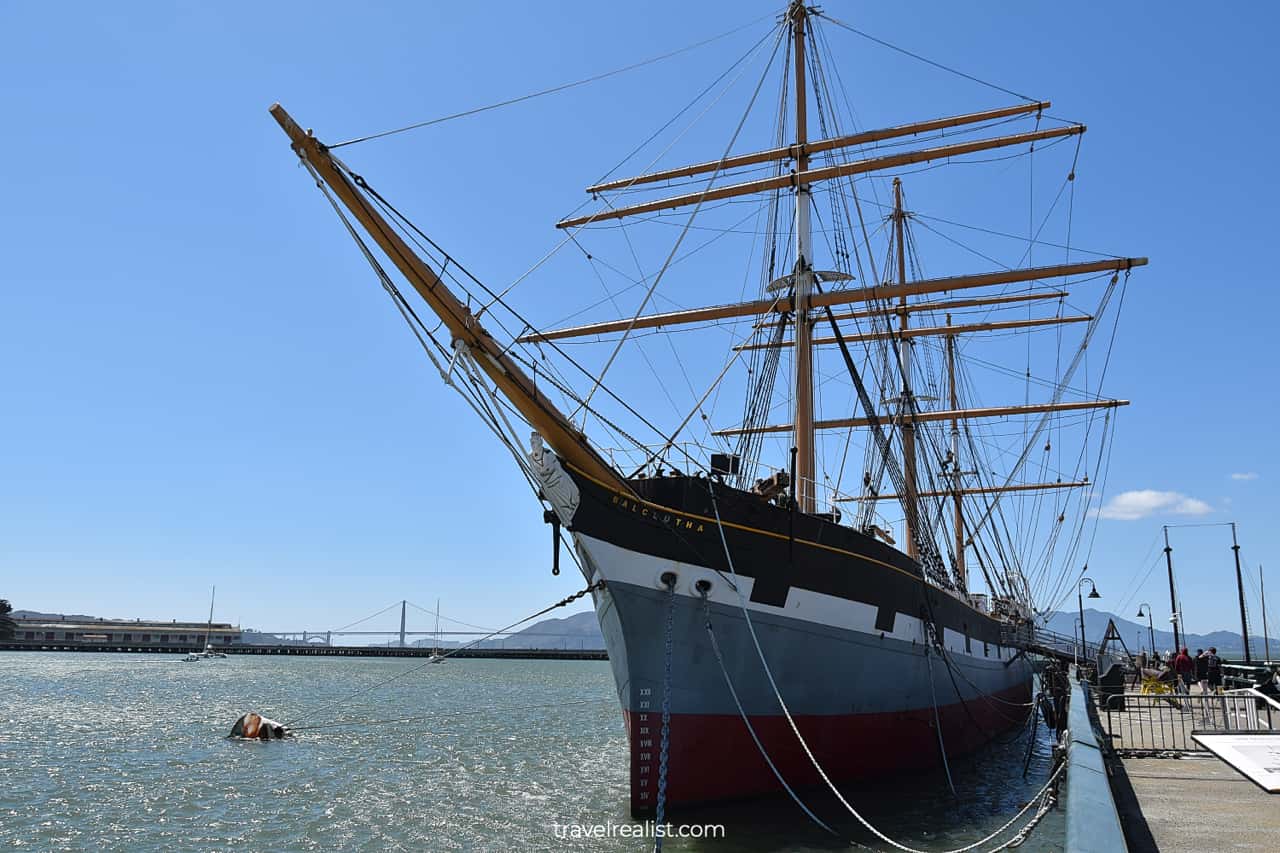
Balclutha means the town of the Clyde in Gaelic Scottish language. But it was not the only name the ship had throughout its long history. There were two other names.
- Sailors knew this ship as Star of Alaska between 1904 and 1933.
- The ship carried the name Pacific Queen from 1933 to 1954.
National Park Service acquired and restored the ship in 1986. It also brought back its original name.
Pay extra attention to the little things on Balclutha. Take a look at the ship’s figurehead. The craftsmanship of the restorers is on full display there.
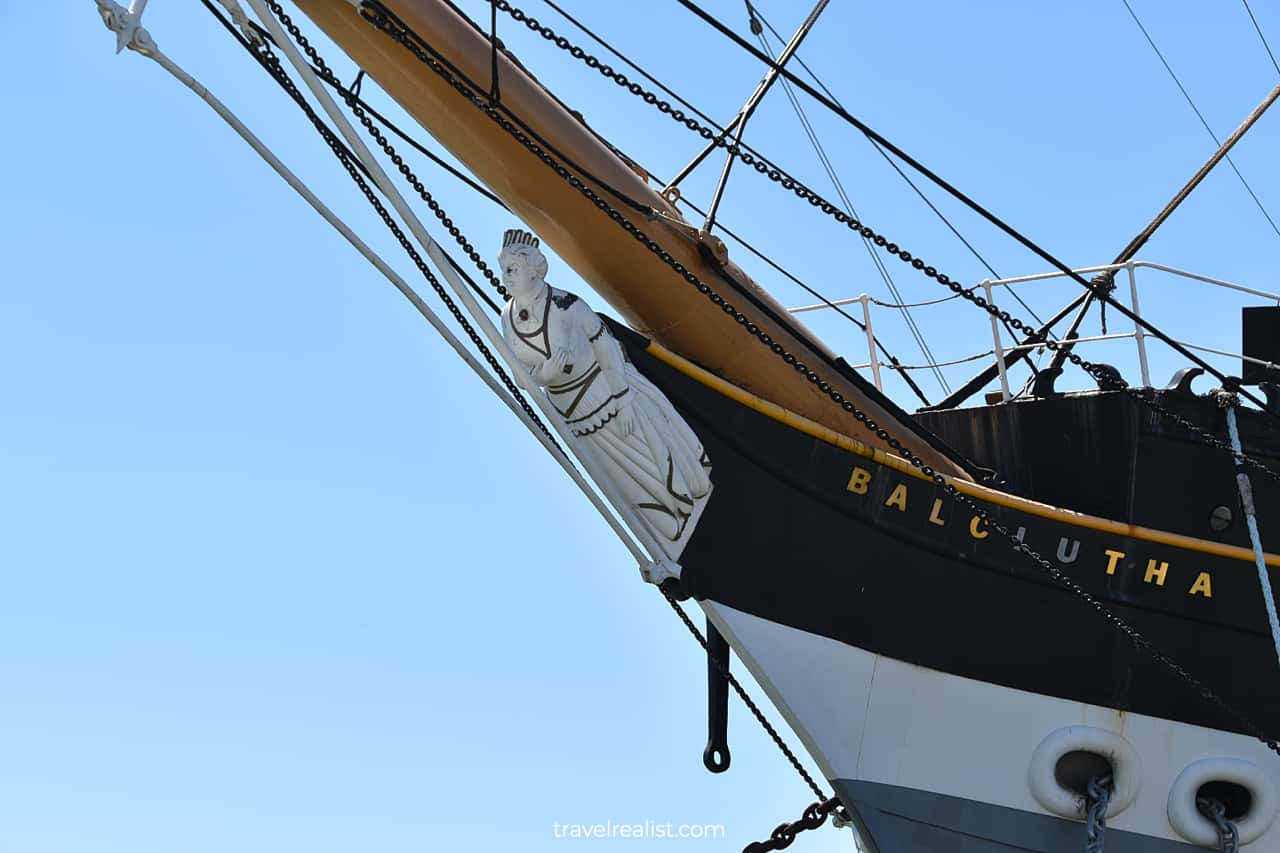
You can board Balclutha and explore its deck. The ship could be under partial maintenance during your visit. A part of the ship will be closed in this case. But you could still explore other areas.
If you happen to visit the ship during re-rigging, you are in luck. You could see fearless professionals at work several hundred feet (meters) above the deck.
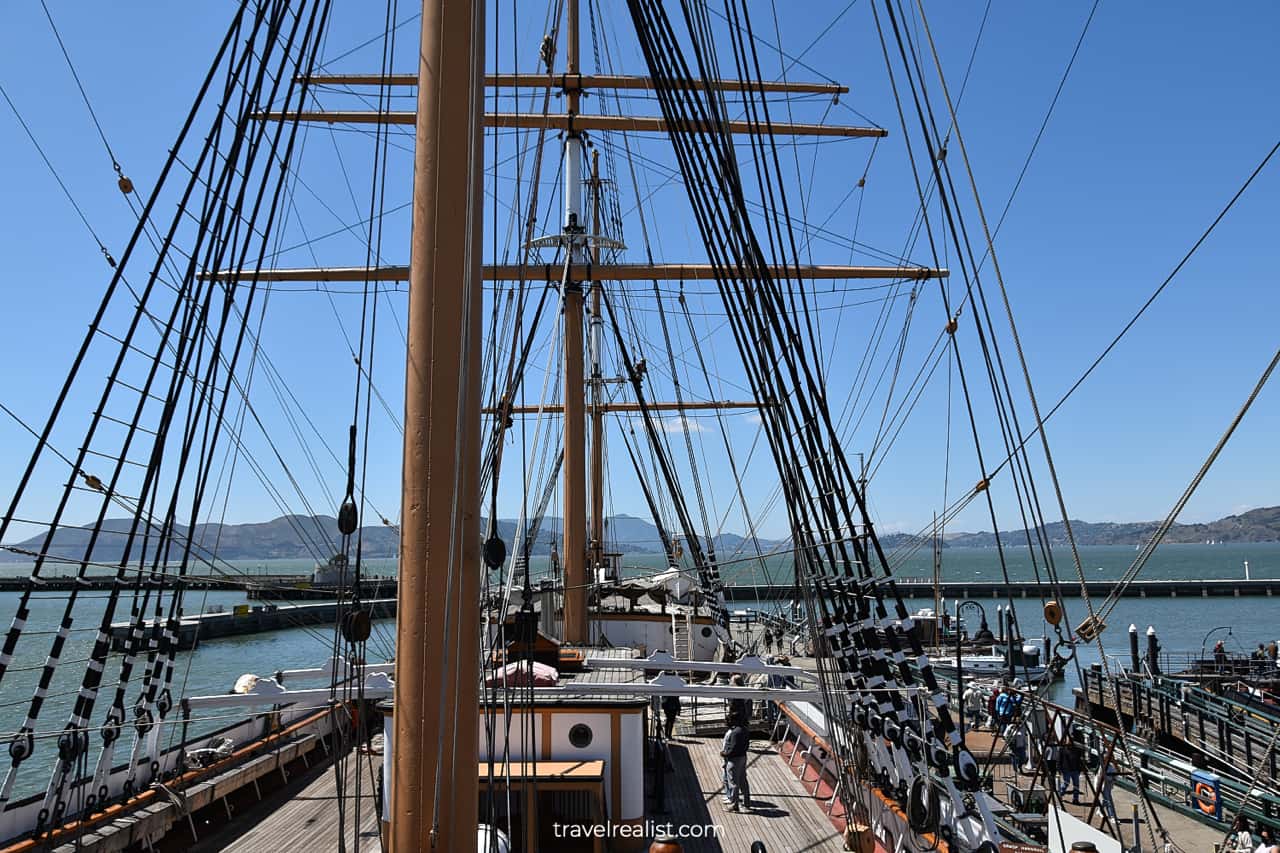
This could be your chance to learn more about the rigging process. Take a closer look at the foremast, its shrouds, fore top, and ropes.
Similar to C.A. Thayer, volunteers are often present onboard Balclutha. You could pick their brain to learn more about square rig sailing ships like Balclutha.
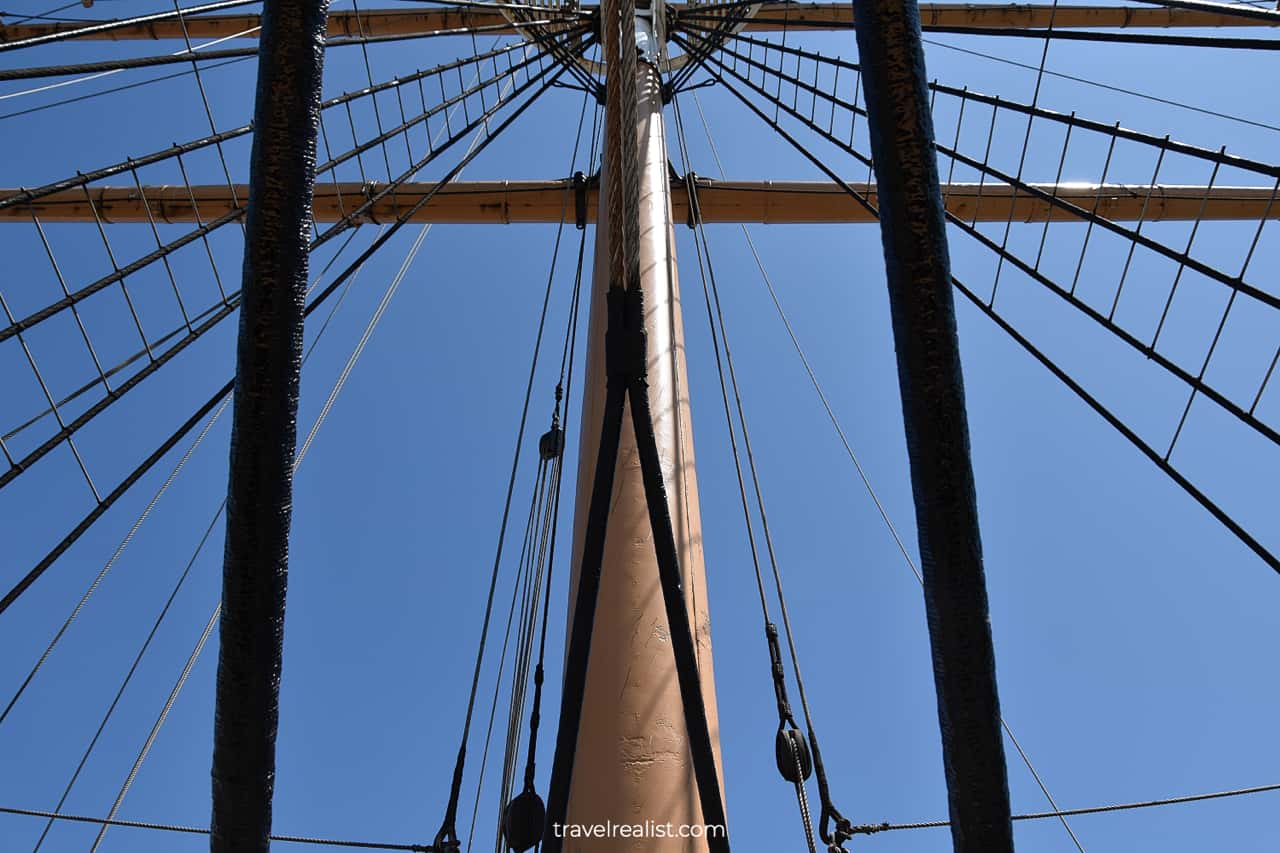
4. Steam Tug Hercules
The next boat awaits as soon as you finish exploring Balclutha. This time it is going to be steam tug Hercules.
Hercules is on the younger side among the park’s vessels. The ship was built in New Jersey in 1907. It was an oceangoing tug in the Pacific for most of its service.
It is incredible to think that this small tug towed a few ships that were several times its size. Hercules towed USS Oklahoma on its final voyage. And USS Oklahoma was nearly 4 times the length of Hercules.
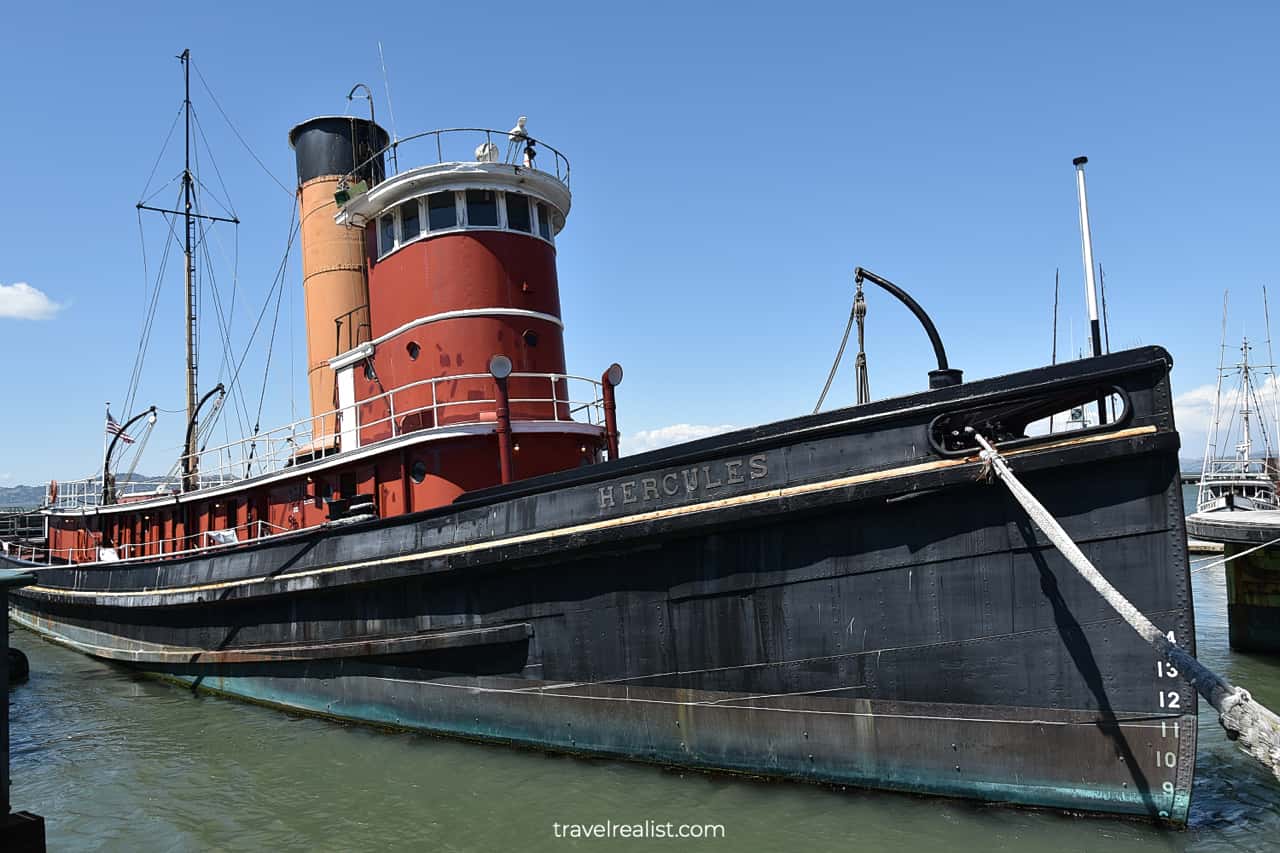
You can board Hercules and explore its quarters up-close. There are a few things to do onboard of Hercules.
- Do not miss a chance to see a massive towing machine of this tug.
- Continue your exploration with a stop at the tug’s galley, an onboard kitchen.
- Take a look at the crew quarters. You will see real differences between the captain, first mate, and sailor quarters.
- Enjoy the views through the ship’s portholes. You can see the Black Point Historic Gardens across the Aquatic Cove.
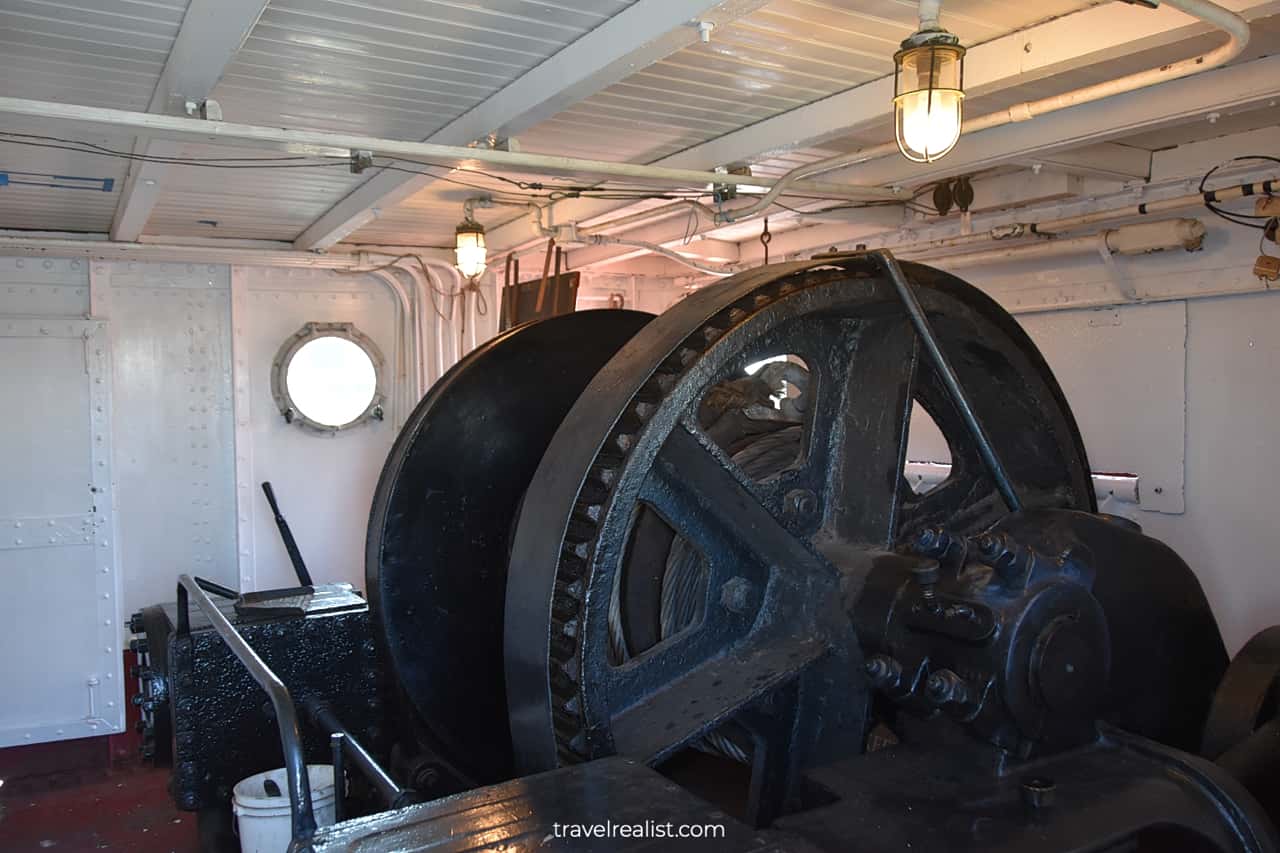
5. Scow Schooner Alma
It makes sense to explore Scow Schooner Alma as the next boat in the park. This ship was built in San Francisco, California in 1891.
The ship carried different types of cargo until 1957. The State of California purchased the ship two years later before transferring it to the National Park Service in 1978.
Alma takes place in Master Mariners Regatta every year. As a result, this ship often undergoes extensive maintenance. You might not see Alma at her mooring if you visit the park in May or June.
6. Steam Ferryboat Eureka
Do not worry if you happen to visit San Francisco Maritime Museum Ships during such time. There is still one more ship to explore at the Hyde Street Pier.
Steam ferryboat Eureka is the largest ship at San Francisco Maritime. It was built in Tiburon, California near San Francisco, California in 1980. Eureka is a wooden-hulled ferryboat.
This ship carried passengers and vehicles. Back in the 1900s, one could catch this ferryboat between San Francisco and Tiburon and later Sausalito. The boat carried railroad cars in addition to passengers.
It sets Eureka apart from other steam ferryboats, like Berkeley in San Diego Maritime Museum. The ship became part of this National Historic Park in 1958.
Eureka is closed to public. You could only explore the ship from the pier.
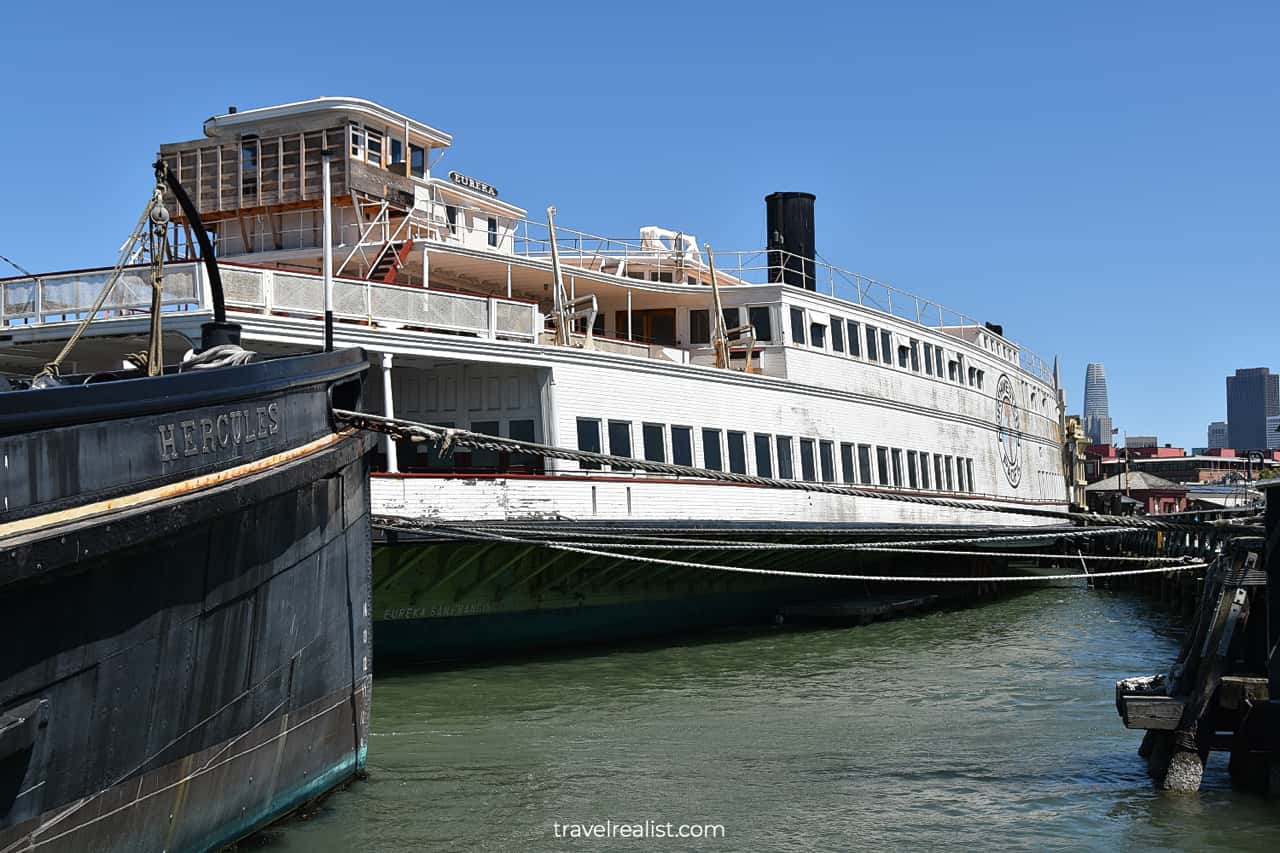
Eureka will be the end of your visit if you follow this Guide to San Francisco Maritime Ships. But it should not be the finish line of your city exploration.
7. Aquatic Cove
Hyde Street Pier is right next to several San Francisco sights. Continue your visit at Aquatic Park. This nearby park houses the Aquatic Cove and Ghirardelli Square.
The Cove is a great place for viewing marine wildlife and birds. Wildlife is plentiful in and near San Francisco Maritime Museum Ships.
You could see a handful of birds during your visit. A double-crested cormorant is a quite common sight. Most sea lions reside at Pier 39. But there is a chance you could also see one in the park.
Ghirardelli Square is a block of historic buildings. These buildings now serve as upscale shops and restaurants. It could a good idea to grab a bite to eat there before you continue exploring San Francisco.
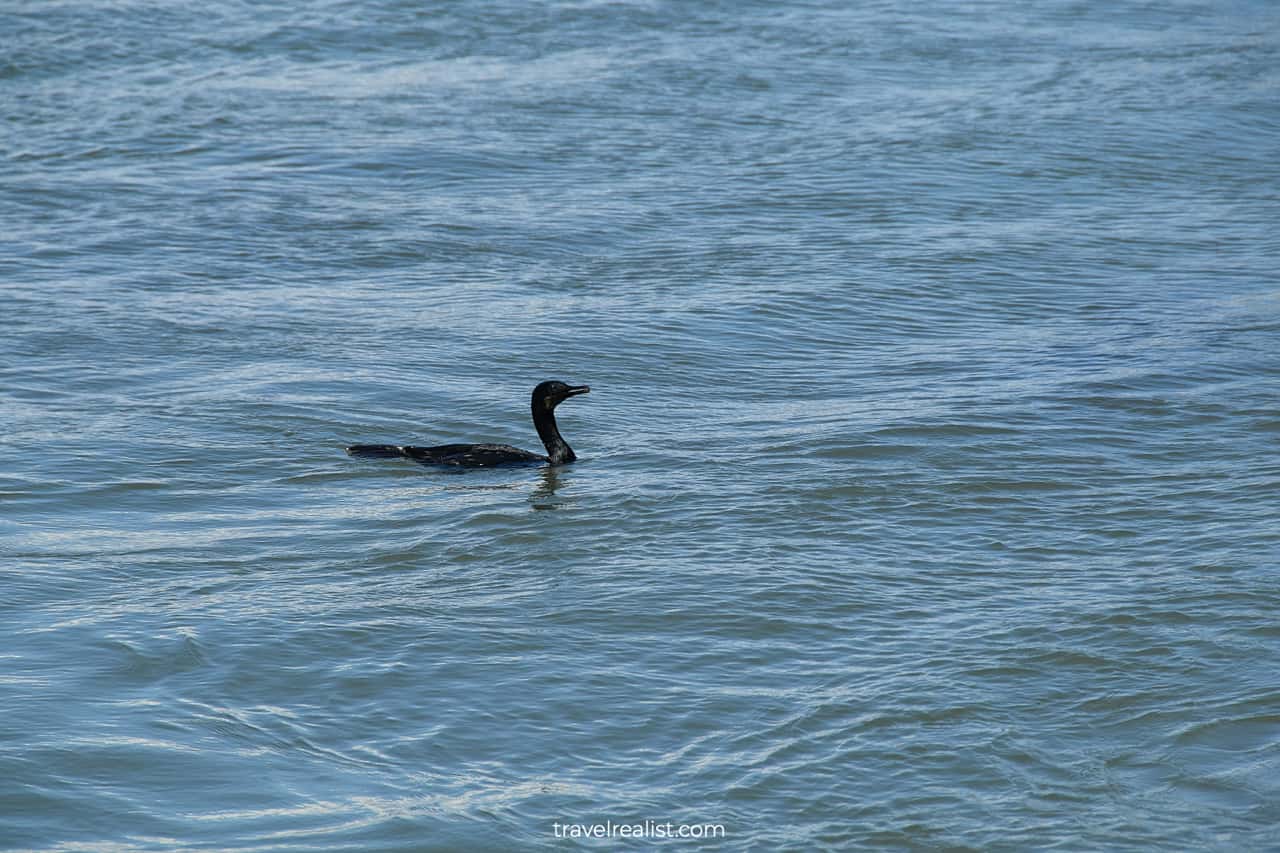
8. Alcatraz Island
You would have to make a decision where to go next.
- You could venture further west to Presidio and the Golden Gate Bridge.
- A visit to Fisherman’s Wharf is another option. You could stop by the famous Pier 39.
- You could go to Pier 33 and hop on a ferry to Alcatraz Island.
Alcatraz Island is one of the most famous sights in San Fransisco, CA. This island has a long history. It housed a maximum security prison until 1963. It was then a place of a political protest for over 19 months.
National Park Service manages the island today. You would need to purchase a ferry ticket in advance to visit the island. The tickets often sell out on weekends. So, it pays off to plan in advance.
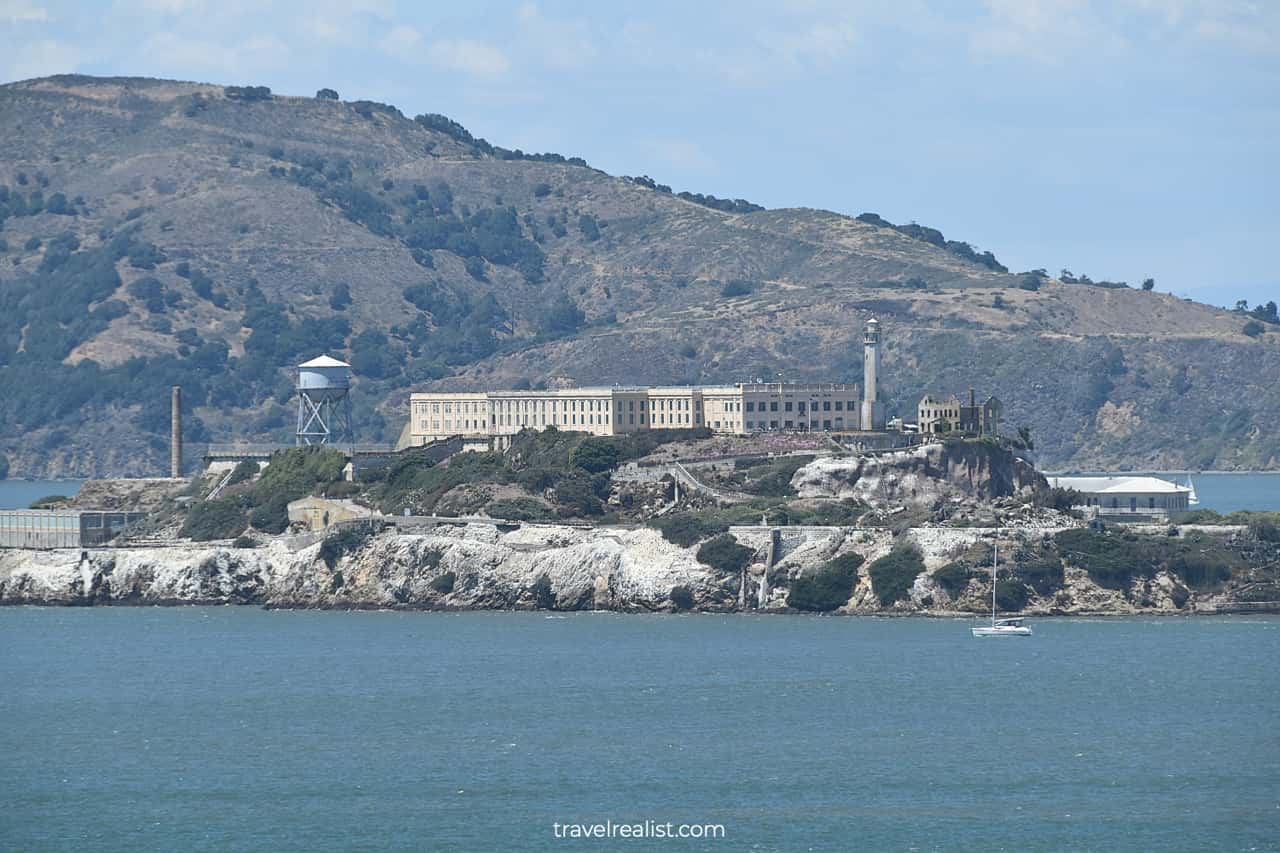
9. Hyde Street Cable Car
Alcatraz will likely not work out as a spontaneous destination. But there is a place that does not require advance planning.
You could ride a historic cable car. Its route takes you up the Russian Hill. Hyde Street has an incredibly steep slope between Hyde Street Pier and Lombard Street.
You can hop on a cable car to save yourself from an strenuous uphill walk. You will also save quite a bit of time by taking a cable car. The cost of the ride is only downside. Get ready to pay $8 per adult.
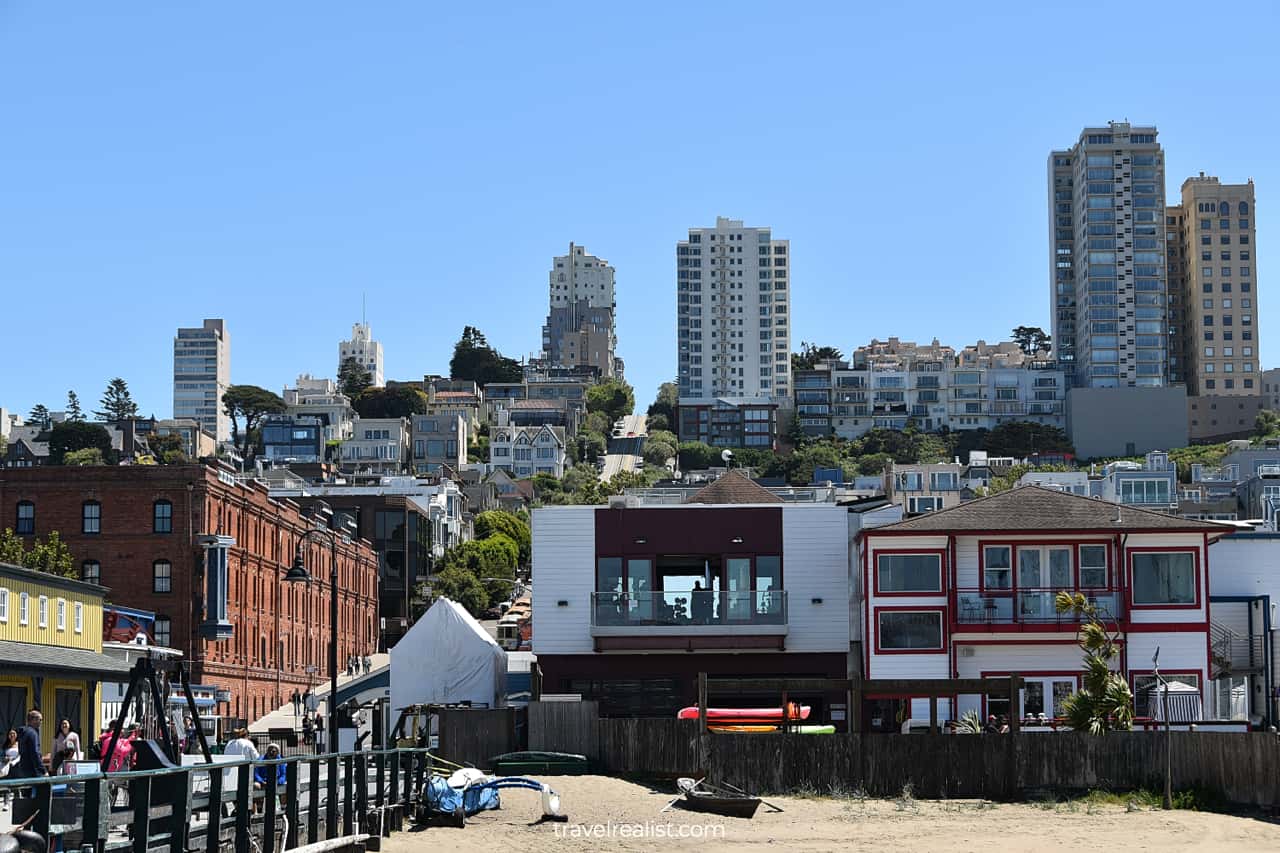
If you decide to walk up to Lombard Street, take your time. This incline is not for the faint of heart. Do not forget to turn around and look down Hyde Street at Lombard Street.
You will get a fantastic panorama of San Francisco Bay. You will be able to see the historic ships at the Hyde Street Pier. All five or six of them will be in sight.
Alcatraz Island and its historic prison will be also at full display. And Angel Island will dominate the background.
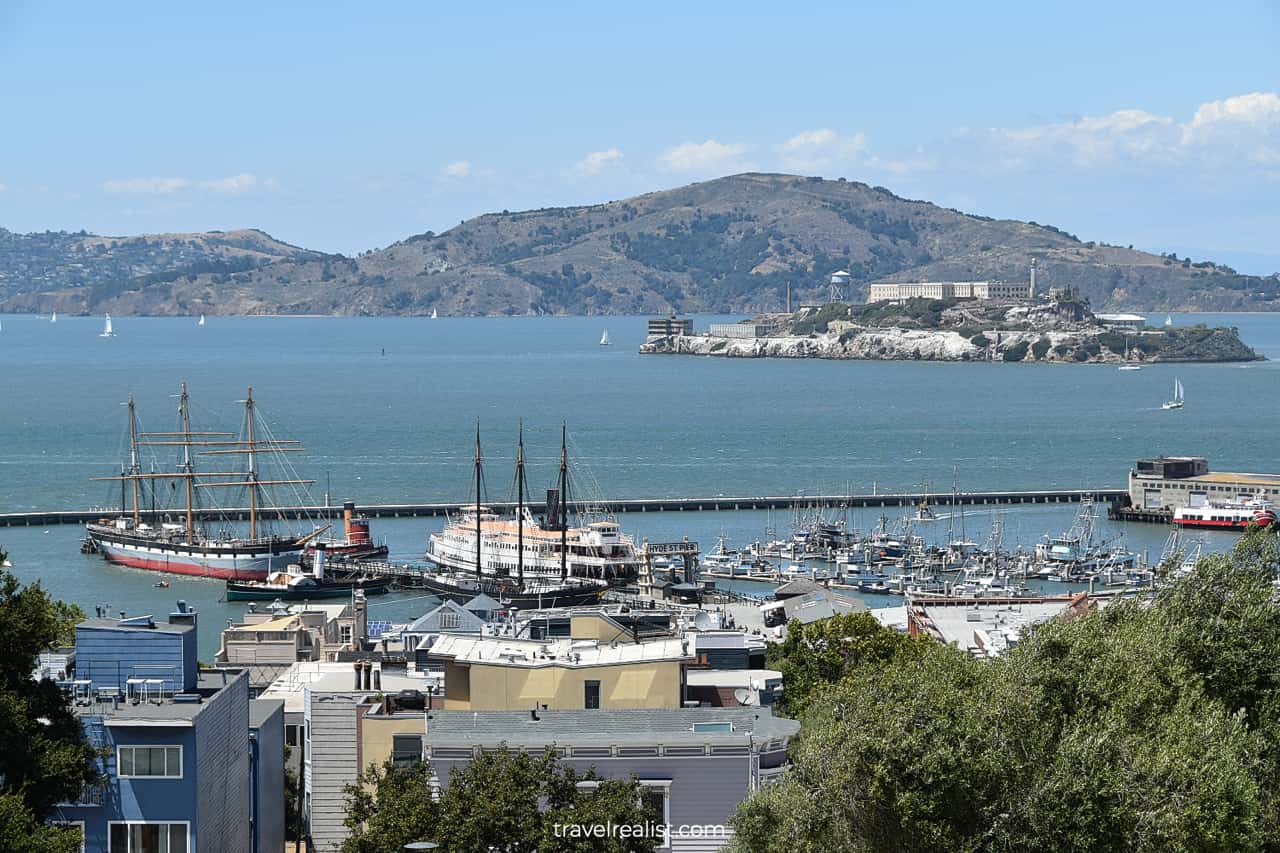
10. Lombard Street & Coit Tower
You will reach Lombard Street. This is one of the most well known San Francisco sights. The street is famous for its 8 hairpin turns. It is free to visit. As a result, this street attracts tourist crowds on any day of the year.
Lombard Street is also a great spot to capture amazing views of the the Coit Tower. It is another San Fransisco symbol.
The tower is open to visitors. You just need to climb another San Francisco hill to reach it. Once there, you would need a timed ticket to ride an elevator to the top.
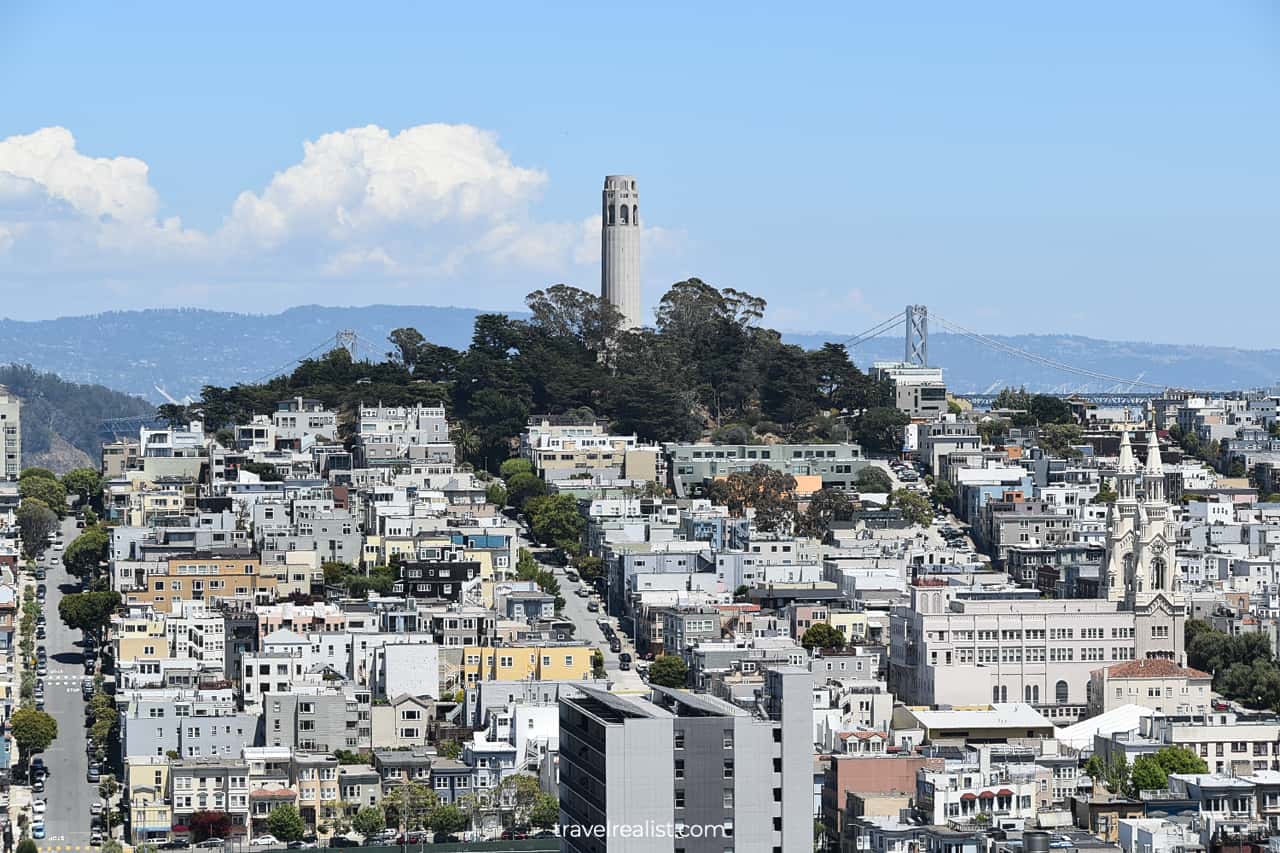
You can reach Haas-Lilienthal House and the Painted Ladies if you continue on Hyde Street towards downtown.
Continue with this Guide to San Francisco Maritime Museum Ships. You will learn more about ways to get to the sights, entrance requirements, and places to stay.
Getting to San Francisco Maritime
San Francisco Maritime National Historic Park is in Fisherman’s Wharf neighborhood. This is one of the busiest tourist areas in the city. A handful of ferries and cruises depart from Fisherman’s Wharf.
The Wharf is home to several museums. There is also a Sea Lion Viewing Area at Pier 39. It is always crowded. The parking is sparse. And its cost adds up quickly.
As a result, it is not the best idea to drive a car to Fisherman’s Wharf.
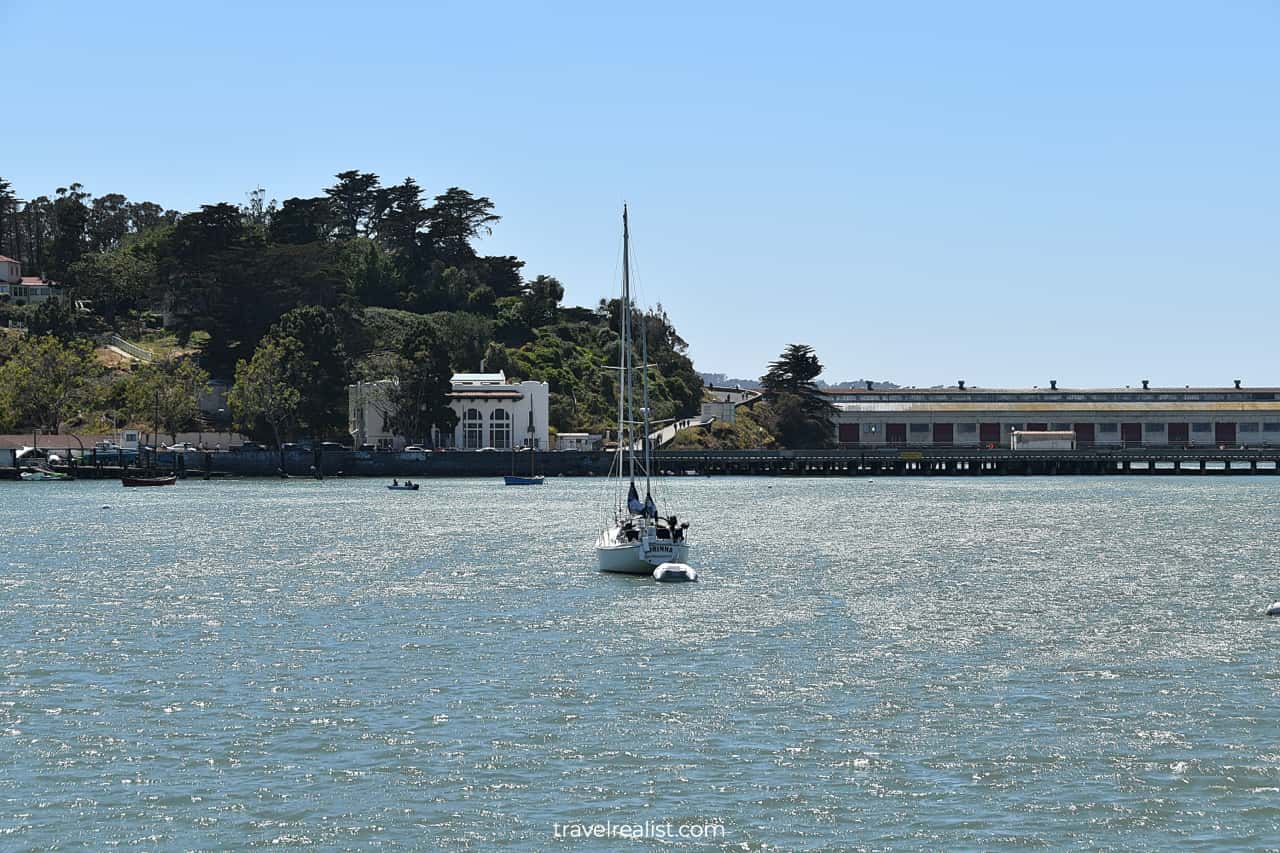
The historic ships are at the mooring at the Hyde Street Pier. You could reach the Pier via public transport.
- The historic Streetcar F is the most cost efficient way.
- A single ride costs $2.50.
- A day pass costs $5. You would break even on a return trip.
- The Historic Powell / Hyde cable car is another option.
- It stops right in front of the historic park.
- A single ride costs $8.
- A day pass with a cable car costs $13. You would break even after a return cable car trip.
- Bus is the other option to reach the Hyde Street Pier with public transport. A handful of buses stop two blocks south of the Pier.
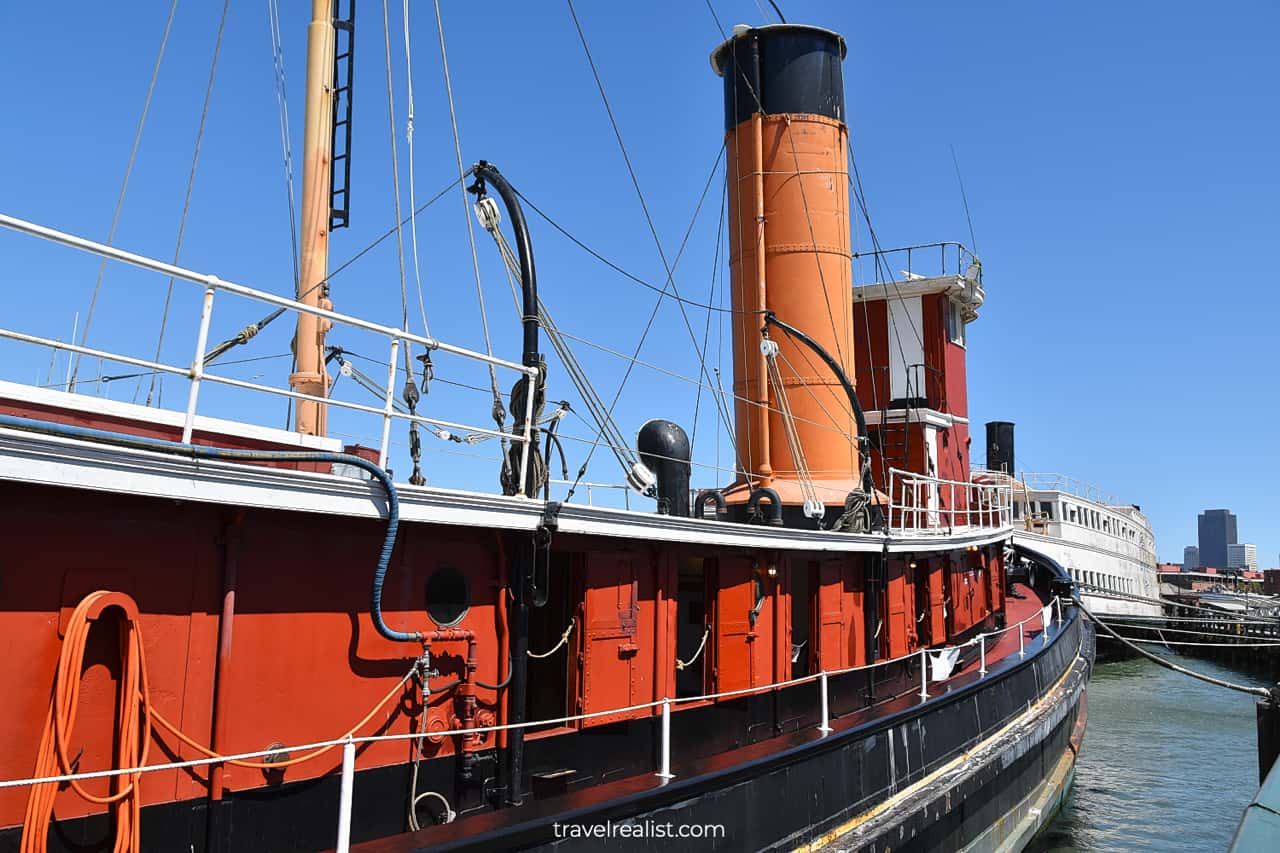
Where to Stay
There are plenty of places to stay near the Hyde Street Pier. But the prices for hotels and vacation rentals in San Francisco tend to be high. Fisherman’s Wharf popularity with tourists plays a role in it.
Thanks to a robust public transport system, you should consider staying further away from the Hyde Pier. Union Square neighborhood properties often post good deals. This area is still very central.
You could use it to reach other Bay Area destinations quite easily easily.
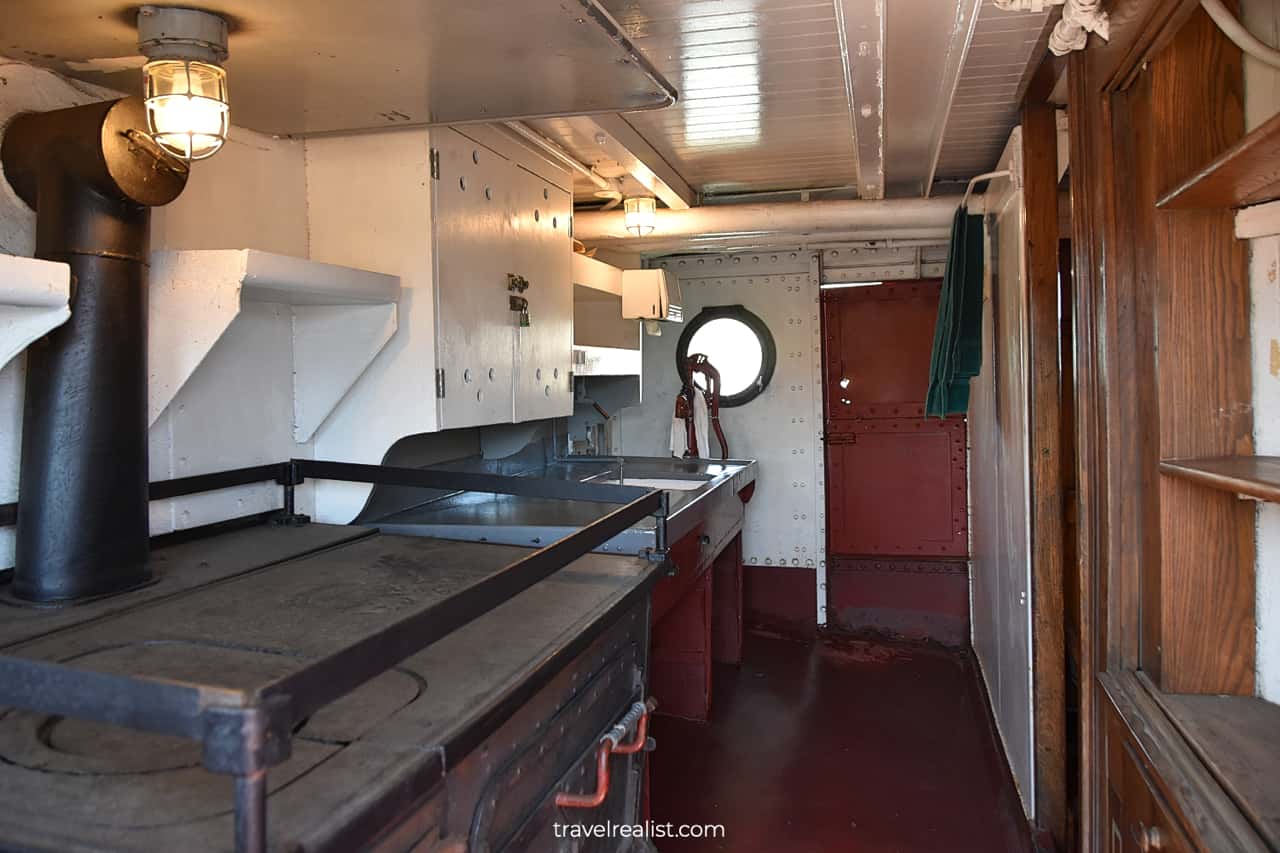
Entrance Requirements & Passes
San Francisco Maritime National Historic Park is open almost every day from 10 a.m. to 5 p.m. The last admission is at 4:30 p.m. The park is closed on Thanksgiving, Christmas, and New Year’s Days.
The park’s museum is open from 10 a.m. to 4 p.m. from Wednesday to Sunday. Three ships are open to public. They include C.A. Thayer, Balclutha, and Hercules. You could only admire the other three ships from the pier.
The park charges admission fees of $15 per adult. Children under 15 visit for free. This is a fairly high admission price. But this museum is still cheaper than similar historic ship museums in San Diego, Boston, and Baltimore.
There is even a way to save when visiting San Francisco Maritime Museum Ships. You need to bring your America the Beautiful annual pass. It will give free admission to you and up to 3 other adults.
Due to the high admission price, an Interagency Annual Pass is a great investment when visiting this national historic park. The pass continues to deliver value in the most unlikely parks, like San Francisco Maritime.
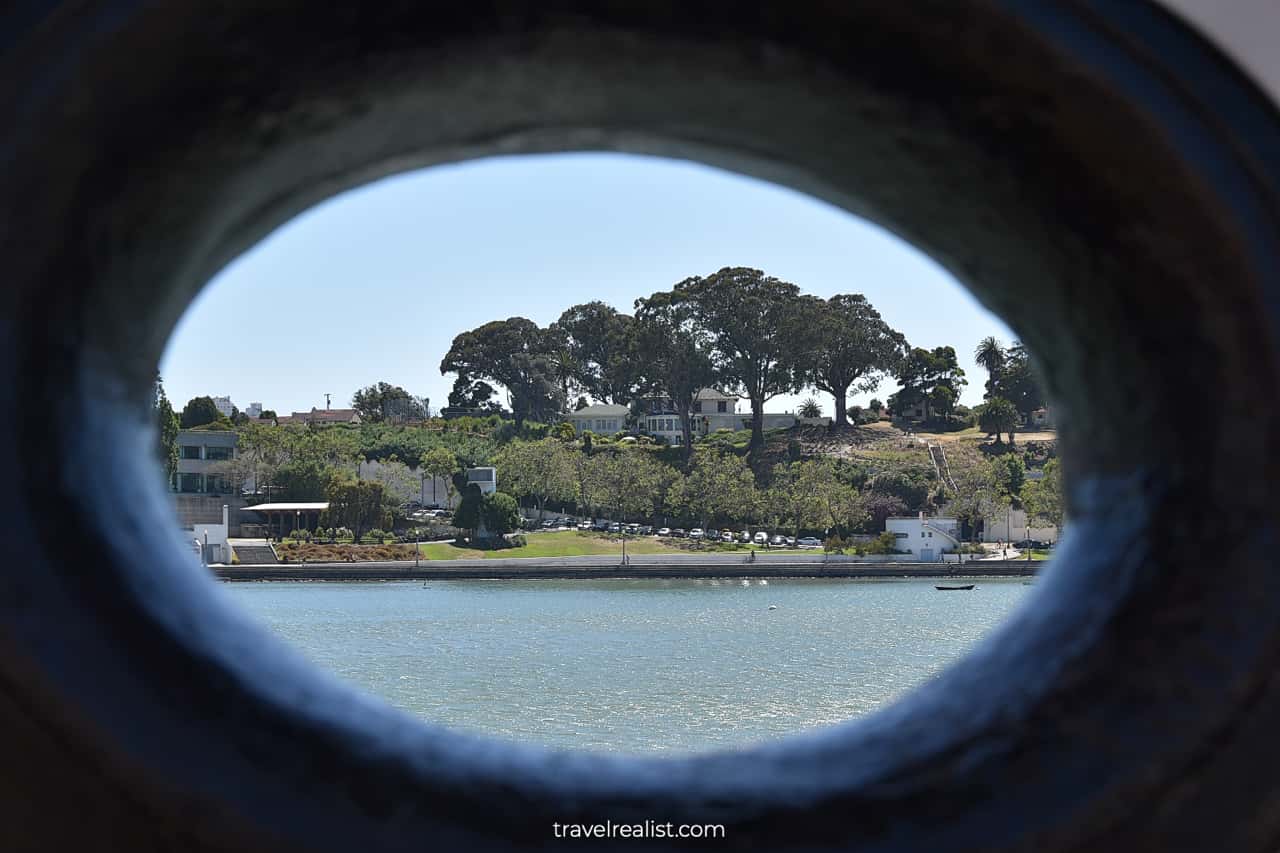
Takeaways: San Francisco Maritime Museum Ships
This San Francisco Maritime Guide documents realistic experience of this National Historic Park. The Hyde Street Pier is a great destination for both ship enthusiasts and history lovers.
The park provides visitors with a chance to explore six historic ships. All of them are over 100 years old.
Keep in mind that per person admission fees are high. Unless you have an America the Beautiful annual pass you might find them difficult to justify.
On the bright side, the fees deter some tourists. It means you can explore the ships with less crowds. This park is for you if you have an annual pass and like engineering.
San Francisco Maritime Museum has one of the best historic ships fleet in the country. It rivals the fleet of San Diego Maritime. And it gives Boston Tea Party Ships and Historic Ships in Baltimore a run for their money.
Take a look at this San Francisco Maritime Museum Ships Video Guide. And visit the YouTube channel for the latest videos.
Frequently Asked Questions
The Hyde Street Pier has 6 historic ships. You can board three of them and admire the rest from the pier.
Balclutha, C.A. Thayer, Eppleton Hall, Hercules, Eureka, and Alma are at their mooring at the Hyde Street Pier.
There are six ships in San Francisco Maritime. You can board three ships. Enjoy the rest of the ships from the shore.
San Francisco Maritime is open most days of the year from 10 a.m. to 5 p.m. Last admission is at 4:30 p.m. The park is closed on Thanksgiving, Christmas, and New Year’s Days.
Visitors can explore the Hyde Street Pier Ships for $15 per person. Children under 15 years old visit free. America the Beautiful annual pass covers admission for up to 4 adults.
The museum is included in the National Historic Park’s admission fee of $15 per adult.
It costs $15 per adult to visit San Francisco Maritime. Children visit the park free. You can get free admission for 4 adults if you have an Interagency annual pass.
Budget an hour to explore 6 historic ships in San Francisco Maritime.
The pier was built in 1922.
You can walk from Fisherman’s Wharf to San Francisco Maritime in 15 minutes. You could also board historic streetcar F or a bus.
Safe realist travels!

